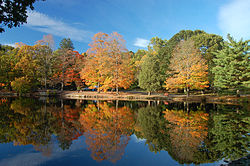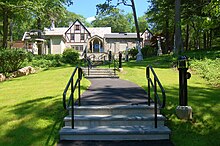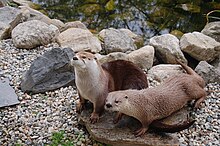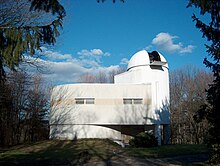
Armagh Observatory is an astronomical research institute in Armagh, Northern Ireland. Around 25 astronomers are based at the observatory, studying stellar astrophysics, the Sun, Solar System astronomy and Earth's climate.

The Genesee Country Village and Museum is a 19th-century living history museum covering more than 600 acres (2.4 km2) located in the town of Wheatland, New York, United States, in the small hamlet of Mumford, about 20 miles (32 km) from Rochester. On the museum property is the 19th-century village, the John L. Wehle Gallery of Sporting Art, the Genesee Country Nature Center, the Carriage Museum, the Silver Baseball Park and the Heirloom Gardens. The facility offers special events and classes throughout the year.
The Hayes Arboretum is an arboretum of 330 acres (130 ha) located in Richmond, Indiana, United States. The main (west) entrance is open free to the public Tuesdays through Saturdays, 9:00 A.M. to 5:00 P.M., while the east entrance, which provides access to both hiking and mountain biking trails, is open daily from dawn to dusk. It is the primary project of the Stanley W. Hayes Research Foundation, a private operating foundation. The Foundation owns a total of 466 acres (189 ha) of property in Wayne County, IN.

The Houston Museum of Natural Science is a natural history museum located on the northern border of Hermann Park in Houston, Texas, United States. The museum was established in 1909 by the Houston Museum and Scientific Society, an organization whose goals were to provide a free institution for the people of Houston focusing on education and science. The museum complex consists of a central facility with four floors of natural science halls and exhibits, the Burke Baker Planetarium, the Cockrell Butterfly Center, and the Wortham Giant Screen Theatre. In 2022, the museum received 1,520,000 visitors, making it seventh on the List of most-visited museums in the United States, and was the third most-visited U.S. science museum. Much of the museum's popularity is attributed to its large number of special or guest exhibits.
The Forest Preserve District of DuPage County is a governmental agency headquartered in Wheaton, Illinois, United States. Its mission is to acquire and hold lands containing forests, prairies, wetlands, and associated plant communities or lands capable of being restored to such natural conditions for the purpose of protecting and preserving the flora, fauna and scenic beauty for the education, pleasure and recreation of the citizens of DuPage County.

In 2017, the City of Stamford established the Stamford Arts and Culture Commission to help bolster arts and tourism in the city.
The North Carolina Museum of Natural Sciences (NCMNS) is a museum in Raleigh, North Carolina. The museum is the oldest in the state.

The Daniel Webster Wildlife Sanctuary is a sanctuary owned by the Massachusetts Audubon Society, the largest conservation organization in New England, in the town of Marshfield, Massachusetts. The sanctuary, formerly the farm of Edward Dwyer, statesman Daniel Webster and the William Thomas family of Marshfield, the first English landowner to live on the sanctuary land, was purchased by Mass Audubon in 1984 thanks to the volunteer efforts of the Committee for the Preservation of Dwyer Farm for the People of Marshfield. The sanctuary contains 507 acres (2.1 km2) of mixed cultural grasslands, red maple swamps, a five-tiered wet panne, Webster Pond and a section of the Green Harbor River. It is the site of the annual Daniel Webster Farm Day celebration. Surrounding lands owned by the town of Marshfield and the Marshfield Airport increase the local open space area to more than 1000 acres (4 km2).

The North River Wildlife Sanctuary is a wildlife sanctuary, owned by the Massachusetts Audubon Society, located on the North River in the town of Marshfield, Massachusetts. The sanctuary contains 184 acres (0.74 km2) of mixed cultural grasslands, red maple swamps, oak-pine woodland, and access to the river. The North River Wildlife Sanctuary came to Mass Audubon as a gift of the Killam and Rodgers families in 1977.

The Phillip and Patricia Frost Museum of Science is a science museum, planetarium, and aquarium located in Miami, Florida, United States. The museum originally opened its Coconut Grove location across from Vizcaya Museum and Gardens in 1960. It relocated to Maurice A. Ferré Park in the downtown area adjacent to the Perez Art Museum Miami in 2017 after the closing of the Coconut Grove location in 2015.
Erie MetroParks was formed as the "Erie County Metropolitan Park District" in 1968 and adopted its current name in 1991. It consists of 14 individual park areas located throughout Erie County in the US state of Ohio covering approximately 3,200 acres (1,300 ha).

The New Hampshire Farm Museum is a farm museum on White Mountain Highway in Milton, New Hampshire, United States. Three centuries of New Hampshire rural life are presented in the historic farmhouse. The museum includes a 104-foot-long (32 m) three-story great barn with collection of agricultural machinery, farm tools, sleighs and wagons. There are also live farm animals, a nature trail and a museum shop. The museum is located on the former Plumer-Jones Farm, a traditional series of connected buildings with farmhouse dating to the late 18th century and barns dating to the mid 19th century, which was listed on the National Register of Historic Places in 1979.
Aullwood Audubon Center and Farm AKA Aullwood Audubon is an environmental education, sustainable agriculture, and Audubon Center of the National Audubon Society. Aullwood Audubon includes a nature center, educational farm and farm discovery center, and a 200 acre nature sanctuary with 8 miles of walking trails. Aullwood Audubon is located in Montgomery County in southwestern Ohio, United States, about 10 miles (16 km) northwest of downtown Dayton.
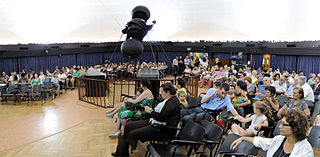
Armand Neustadter Spitz was an American planetarium designer.
The Autrey Mill Nature Preserve & Heritage Center is located in Johns Creek, Georgia, United States.

Moose Hill Wildlife Sanctuary is a 1,971 acres (798 ha) wildlife sanctuary located in Sharon, Massachusetts. The property is the oldest property of the Massachusetts Audubon Society, established in 1916. It is adjacent to Moose Hill Farm, which is owned by the Trustees of Reservations.

The Royal Eise Eisinga Planetarium is an 18th-century orrery in Franeker, Friesland, Netherlands. It is currently a museum and open to the public. The orrery has been on the top 100 Dutch heritage sites list since 1990. In September 2023, it received the status of UNESCO World Heritage Site. It is the oldest working orrery in the world.
Robert Edward Cox was an American optical engineer and a popularizer of amateur telescope making. He conducted the popular "Gleanings for ATMs" column in Sky and Telescope magazine for 21 years.
The Von Braun Astronomical Society is a society of amateur and professional astronomers dedicated to education and public outreach on behalf of astronomy based in Huntsville, Alabama, United States.

Drumlin Farm is a 291 acre farm and wildlife sanctuary which is also the site of the headquarters of the Massachusetts Audubon Society. It is located at 208 South Great Road in Lincoln, Massachusetts.
